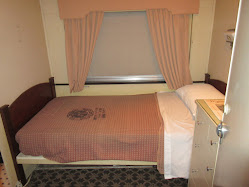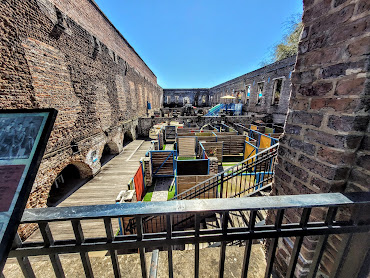Our stay in Belle Bluff was located between nowhere and Savannah... so we decided to visit Savannah... it was fun.
We drove into Savannah, and the downtown/historic area is not designed for large trucks, but we navigated to a public parking lot at the place we caught a riding guided tour of historic Savannah. There were two options: 1) ride the trolley through the entire route, 2) the ability to get on and off at each stop. Unknowingly we made the better choice... we just rode the route. Even with all the tour trolleys running, people were still having to wait for trolleys that had space.
Once we got on the trolley, they took us to the first stop to get more riders, and pay for our tour. This young lady (Rosie) came aboard to tell us what to expect on the tour, and collect our monies.At several of the stops they had actors climb aboard to tell stories about Savannah before and during the Civil War. Surprisingly, they stopped at a lot of historic structures; the driver was very knowledgeable about of the buildings we passed on the tour too.
Some of the buildings that were built in the late 1700s are showing signs of structural damage due to the ground shifting or sinking. A prime example was an old pirate's house.
If you look real close at the door, you will notice the header over the door. Another example is the Savannah Cotton Exchange building, where an entire section is collapsing due to the ground deteriorating. I am not going to show you that part, but I will give you a glimpse of what took place when cotton was being sold here.This was one of the streets that would have been traveled to get down to the harbor and these were steps were made over 150 years ago by slaves. As the trolley continued down that street, we arrived between two large warehouses, and the Cotton Exchange building, and there were catwalks between the buildings.This is just one side of the catwalks. Imagine a herd of cotton merchants standing on those catwalks, wheeling and dealing on the cotton wagons driven underneath them. Europe was the biggest customer for cotton in the day.
As the trolley continued down that street, we arrived between two large warehouses, and the Cotton Exchange building, and there were catwalks between the buildings.This is just one side of the catwalks. Imagine a herd of cotton merchants standing on those catwalks, wheeling and dealing on the cotton wagons driven underneath them. Europe was the biggest customer for cotton in the day.The tour took us around to a few food places the driver felt worthy of visiting, then it was back to the parking lot. Carol and I decided that we would walk the historic sites after lunch.
Before lunch we hit a couple of museums, Savannah History Museum, and Georgia State Railroad Museum. The history museum was first, because it was right off the parking lot from the tour trolley.
The history museum took us through the city's history from 1733 though the Civil War, and then to today.
Try to imagine yourself living around 1750, in a home similar to your distant neighbor, if you are farming, or a closer neighbor if you live in town. Today we would call these similar homes a housing tract.
You house probably looked like this. Building your home was probably a community effort because of the various skills required. The roof for instance, was made of either cypress or cedar shingles, and someone knew how to split the wood. Your house would have had a large fireplace for cooking and heating. In the early days of 1750, your chimney was made of mud and sticks. By 1779 though, it was required that houses in town must have brick chimneys... fire safety you know. Back to your house in 1750. That large fireplace sounds neat for cooking, but it stunk for heating the house, all the heat went up the chimney. Living in town might have meant that you had a yard around your tremendously large house of16 feet x 24 feet, which roughly came to 750 sq. ft. The first floor was your parlor and hall (where he fireplace is located). The second floor would have been sleeping quarters. From the first floor you had a narrow staircase leading to the raised cellar. In those days you know where you found the toilet facilities.... yup, outside in the yard. Speaking of the yard, it was a busy area at your house. The yard saw laundry being done, soap being made, chopping of firewood, food prep, and possibly children running around.If you lived in Georgia during the mid-1700s, and you were a farmer, growing rice... yes rice, not cotton. Rice was Georgia's first cash crop... thanks to slavery. Georgia's initial charter banned slavery, but that changed when they began importing slaves from West Africa. By 1859, Georgia was responsible for growing 51 Million pounds of rice. Georgia was extremely successful thanks to those slaves from West Africa.
While Eli Whitney was credited with inventing the cotton gin... which he did not... he merely invented a better cotton gin. Eli's gin used wire teeth to separate the seed from the cotton, vice a roller in the original version, which squeezed the seed out of the cotton. in 1794 Eli Whitney went into a partnership with another gentleman, and patented his version of the gin. Funny thing about some new inventions... they bring greed along for the ride. It was no different here with Eli and his partner Phineas. His machine would take 5 pounds of seed cotton and produce 1 1/2 pounds of clean cotton, which they kept a 1/2 pound for services, and gave the farmer back 1 pound. The farmers thought the price was too steep, the outcome was pirated versions of the cotton hit the market. The picture is an example of one of the pirated gins. some of those pirated gins made an improvement to Whitney's design... they used saw teeth instead of wire teeth; they were more stable and reliable.
This museum covered the way of life here in Georgia, including animal interest stories.
By the 1800s Savannah had become a hub for railroads and shipping. Here they were interested in Buster. We see Buster reading an announcement about efforts to save fuel. So what makes this story so interesting, a dog that can read? No. Actually this little guy was trained to pickup lumps of loose coal and place them in a box for that purpose. His efforts endeared him with the engineers, firemen, and trainmen of the district. Buster was such a hard worker that he appeared on the cover of The Right Way Magazine, an employee magazine published by, and for, the Central of Georgia Railway Company. As the story read regarding his dedication to fuel economy: "He hangs around the coal chute all day, and whenever coal drops from the chute or from the tender of an engine, he gets busy and carries it to the scrap box near the chute. If he finds a lump of coal too large to carry, he lets the boss know he has found a prize he cannot manage and someone goes to his assistance and places the coal in the box."A piece of fairly current history some of you may remember. The story is about a young man, not quite all there mentally, but very positive about the world and people in it. He comes home looking for friend of his, and while waiting, he is sitting on a bench:
If you need more clues, he was talking to a lady about life, and how it was like a box of chocolates. Last clue... it was Forrest Gump. This park bench is the actual bench he was sitting on while the movie was being filmed here in Savannah.Savannah was around before the Revolutionary War. In 1775 it was a bustling shipping port, and there were all kinds of people from Europe living here. Some of those from Europe were indentured slaves paying for the passage to America, others were lifetime slaves from Africa. The Native Indian was not a part of society, they had been pushed out.
Imagine living in town and seeing most of the houses painted red or blue, walking the streets with the aromas from bakeries and food being cooked, mixed with the smells of waste from outhouses poured in the streets, and trash everywhere. You think we are the only era to struggle with disease... think again. In 1775, summer and early fall brought the threats of malaria and yellow fever, along with other diseases... only then the disease were not as treatable. So if you have complaints about how life is going now, look back a short time.
We walked into another room to learn something about Girl Scouts. You can't talk Girl Scouts without first talking about the Boy Scouts.
Sir Robert Baden-Powell, the gentleman that founded the Boys Scouts. He was a British war hero during several wars, one of which utilized boys as runners, standing guard, and helping in the hospitals. These responsibilities were incorporated into Boy Scout activities. After returning to England, and pursuing his interest in education, he wrote the first installment of a six-part manual, called Scouting for Boys.Lets now meet Juliette "Daisy" Gordon Low. The photo is her around age 16. Her family, a Savannah family, regained economic prosperity after the Civil War. She liked her life of prominence, as her family's friends included presidents McKinley and Taft, and Rudyard Kipling. Daisy had some health issues, one being partial hearing loss. This loss put her at the fringe of many conversations. Time moved on, Daisy married and moved to England. After getting past a bad marriage, she wandered Europe for awhile before returning to England. Back in England she happened upon a luncheon party in 1911, where she met Sir Robert Baden-Powell, this was the ground level for Girl Scouts. One thing Daisy was sure of when it came to the future Girl Scouts... no girl would be left out... she understood being left out because of her partial hearing loss. In 1912 the Girl Scouts were founded.This uniform, the bloomers, circa 1935-1948, allowed the girls to play sports uninhibitedly.
Here is one for you regarding girls wanting to be in the Boy Scouts. Back before the Girls Scouts, Sir Robert Baden-Powell created the Girls Guides in response to the 8,000 girls in England desiring to have the same fun as the boys. The blue uniform would have been what the girls wore in 1909. Keep in mind, the Girl Scouts were founded in 1912.
The first uniforms were similar to the Girl Guides uniform. This uniform is circa 1919, consisting of a khaki coat dress, and hot in warm climates like Hawaii and Savannah. Around 1920 there was an addition to Girl Scout uniforms for those girls living in warm climates, allowing the warmer climates to wear white uniforms.
The locomotive and train cars are all decanters holding Jim Beam Kentucky Bourbon. The set shown is circa 1979. The decanters are made of Regal China Porcelain, and containing 12 1/2 year old straight bourbon whiskey.
Its just a short walk to the train museum, so off we go. The starting point was the old Foreman's Office, which is now the gift shop. Visitors can either go on a self guided tour, or wait for the tour guide. In the bays are various locomotives and train cars, but the main attraction is the roundhouse turntable.
The turntable is still operational, and we got to see it in action later in our tour around the facility.Carol and I arrived at the most opportune time... the tour guide returned for the next guided tour. We strolled to the first bay in the roundhouse to see a working yard locomotive. In the early days the engine was always kept ready for operation 24 hours a day. What they would do is keep a small coal fire in the box
at night so that steam pressure would not be lost, and they could build a bigger fire in the morning when they were ready to use the engine. Later years saw the engine retired, and replaced with a diesel-electric engine. A Catepillar diesel engine, which drove a electrical generator.The front portion of the engine here is the diesel engine, and the smaller compartment is the electrical generator. As time moved on, this engine was also retired for newer technology.
A little quick history on the Central of Georgia Railroad. It was created to compete with the South Carolina Railroad (SCR) running around Charleston. Before the SCR came along, a lot of the cotton was barged down to Savannah, for shipment overseas. With the SCR, business was diminishing in Savannah and going to Charleston, their rival port. By 1836 Savannah started construction of the Central of Georgia Railroad shop complex.
FUN FACT: What did the Central of Georgia Railroad have in common with the Girl Scouts... the first president of the railroad was William Washington Gordon, the grandfather of Juliette "Daisy" Gordon Low.
The first full year of operation was 1840, carrying freight, passengers, and mail. The first year saw 70% of the revenue come from freight, which was cotton from the inland plantations being shipped to Savannah for export.
The Civil War changed the railroad's income from mostly cotton for export, to passenger travel; this was because of the Union blockades preventing the export of southern cotton. Before the war Central of Georgia controlled 229 miles of the 1,420 miles of track throughout Georgia. They had 59 locomotives and 729 rail cars. Thanks to General Sherman the railroad company lost 140 miles of track, 14 locomotives, and 97 rail cars.
The railroad continued to rebuild, repair, and grow, and by the 1920s reached its peak, and during the depression, Central of Georgia was the largest employer in Savannah. Remember I said earlier that steam engines were replaced by diesel, that would have been around 1940. In 1963 the Southern Railway acquired the Central of Georgia, and closed down the Savannah operations.
FUN FACT: it was believed that when Sherman marched to Savannah, he destroyed everything in sight, not true. He went after properties used for waging war in the south, only targeting food, warehouses, train depots, factories, and cotton gins. He never attacked personal residences. His march was also responsible for the emancipation of thousands of African-American slaves. Sherman's "hard hand at war" demoralized the Confederates, quickening the end of the war.
Back to the tour. We were able to walk through a couple of the rail cars that were restored.
As you might be able to see, this car was designed with a bit of luxury while traveling. The car also had quarters for the railroad staff so they could prepare meals and service the compartments.

























































No comments:
Post a Comment